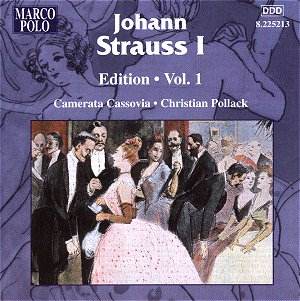Marco Polo have been working steadily through
the Strauss family for some time and here is the first instalment
of a series dedicated to the father.
Apart from the inevitable Radetzky March, Johann
Strauss Senior has tended to be honoured more in name than in
fact, and is much less frequently heard than any of his three
sons. This disc presents his first nine opus numbers plus a few
unnumbered works, all from the latter half of the 1820s. It proves
to be expertly turned, melodious music, making for enjoyable listening;
yet it prompts a thought which is perhaps endemic to the nature
of light music. Since I would not go so far as to call anything
here actually memorable, are the pieces not in a certain sense
duplications of each other? Is there any particular reason to
listen to the six waltzes included here once each rather than
one of them six times over? Would you even notice the difference?
I know this is not a very nice thing to say when
Marco Polo are setting out to explore the composer’s complete
output, and maybe the works from the next two decades will tell
another tale, but if you are not a Strauss completist and if,
when Volume 2 comes out, instead of buying it you just play Volume
1 again, I suggest you may not miss very much, the more so when
the performances are adequate for their purpose rather than wonderfully
inspired.
There are two ways of interpreting this repertoire.
One way – the "concert" approach – is to treat each
piece as a symphonic poem, tickling and teasing the ear with tempo
changes, rubatos and other forms of agogic freedom. This is the
approach which has been sublimated by the catwalk of podium luminaries
– with Herbert von Karajan and Carlos Kleiber at their head –
who have led the Vienna New Year’s Day concerts since the ousting
of Willi Boskovsky in the early 1970s. The other way – the "dance"
approach – is to set up a chunky, chirpy lilt and then hold the
tempo straight down the line, with just a minimum of schmaltzy
up-beats as a new section begins. The principal exponent of the
"dance" approach was Robert Stolz, who recorded a vast
selection of this music in his later years. Critical opinion tends
to favour the "concert" approach; the undersigned, while
not deaf to the allure of Carlos Kleiber in particular, prefers
not to have the music mauled about at the conductor’s whim and
therefore prefers the "dance" approach, as long as the
conductor is able to keep the rhythms alive, something at which
Stolz was adept. And incidentally, the recordings conducted by
Johann Strauss IV are strong evidence for the "dance"
approach.
Wherever you stand on the issue, you will surely
recognise the utility of putting a documentary edition such as
the present in the hands of a conductor who favours the "dance"
approach, especially when the conductor has a Stolz-like ability
to keep the rhythms alive and fresh. Christian Pollack is Viennese,
has studied with Hans Swarowsky and Sergiu Celibidache and made
his first appearance as a conductor in 1971. A musicologist as
well as a conductor, he has made a particular study of the Strausses
and Viennese dance music. His basic approach seems to me to be
exactly right. In the Camerata Cassovia he has a small ensemble
(one string to each part) very much in line with those to be heard
in the ballrooms of old Vienna, including Lanner’s and Strauss’s
own which had three violins and a bass, percussion and a number
of wind instruments which grew from six in 1826 to ten in 1829.
We are given no information about the present orchestra but I
wondered at times if original instruments were being used. A further
characteristic of the typical dance band of 1820s Vienna was that
(I imagine) ensemble was inclined to be rough and ready and tuning
even more so. Unfortunately the present performances are only
too authentic from this point of view, to the extent that I wondered
if this was in fact an all-professional group. While enjoying
the general approach, I felt obliged to listen to the disc in
several instalments, taking it off when the raucous ill-tuning
(spotlighted by a brilliant and very close recording) started
to get me down.
You will gather that this is not a disc for those
who just want a selection of Strauss in their CD libraries. Completists
should be fairly well satisfied though they are likely to wish
Pollack had had a better orchestra to work with.
Christopher Howell
